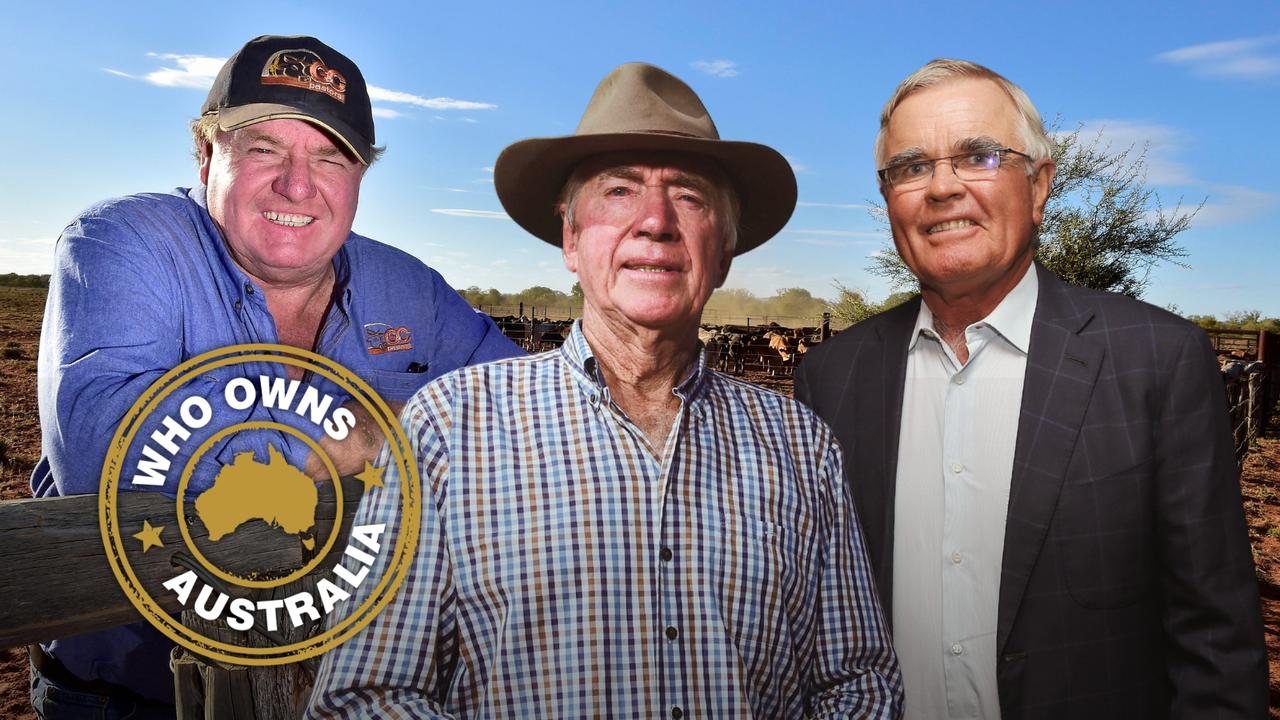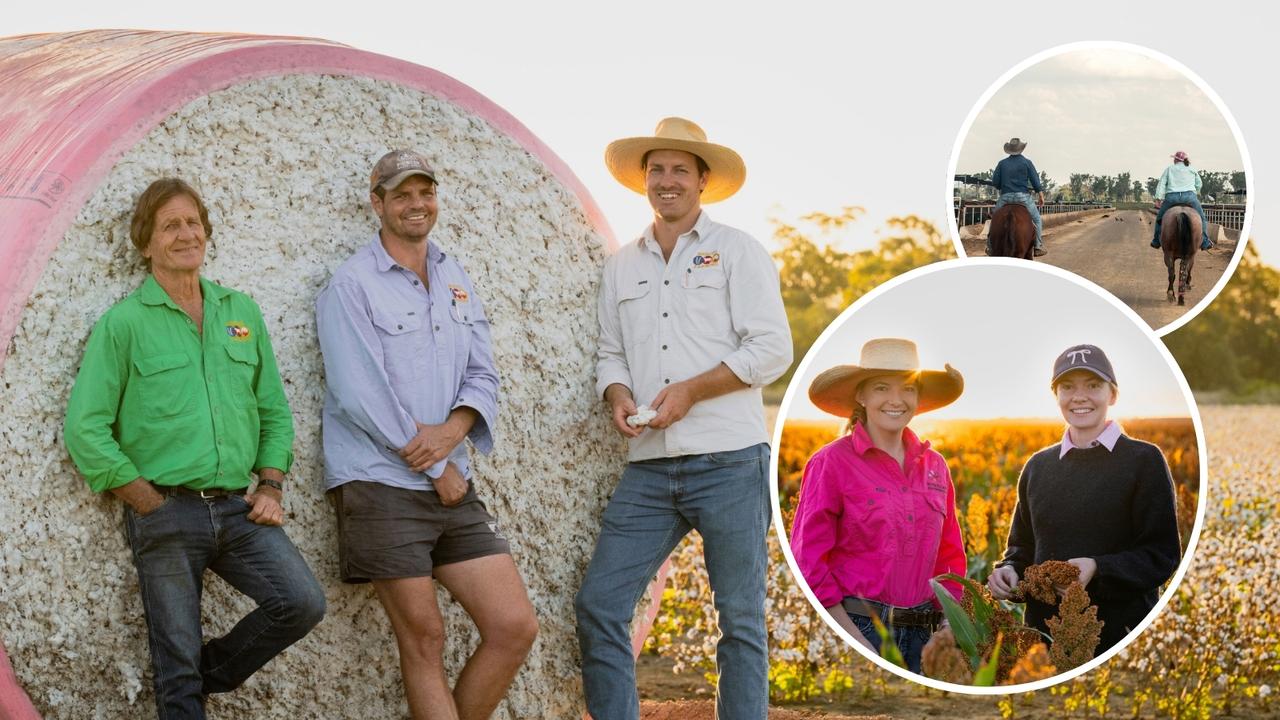Peter Hughes is Australia’s undisputed cattle king
He’s one of Australia’s most highly respected cattlemen with a $600 million Wagyu empire, but this astute station owner has built it all by staying true to his rural roots.
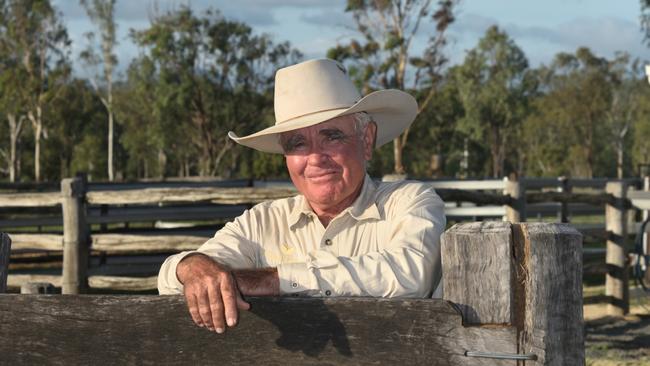
It’s smoko time on a sunny March day in central Queensland, which for Nebo cattleman Peter Hughes, means it’s time to stop the Toyota by the side of the rippling Connors River and boil the billy.

As Hughes gathers sticks and wife Jane Hughes lays out the sandwiches on the tray of the dusty Landcruiser, it is hard to believe the down-to-earth couple picnicking on the quiet paperbark-lined creek bank rank among Australia’s most wealthy families and biggest landowners.
But for both Peter, 73, and Jane, 71, a day spent out in the bush and grassy paddocks of 160,000-hectare Tierawoomba station is a day well lived.
Tierawoomba, 100 kilometres inland from Mackay in central Queensland, is the beating heart of the Hughes family’s cattle empire, which now covers nearly three million hectares of northern Australia and central Queensland.
It’s been a quiet expansion over the past two decades – along with an astute call to experiment crossbreeding with Japan’s pampered black Wagyu cattle breed way back in 1992 – that has seen the Hughes family and its two associated cattle companies, Hughes Pastoral and Georgina Pastoral, rise to be a superpower in Australia’s beef industry.
With current cattle and rural land prices at record levels, combined with a recent decision to run only purebred Wagyu cattle producing “luxury beef” across their five major cattle stations, the Hughes family’s wealth is now estimated at a conservative $600-$700 million. The Australian newspaper’s 2021 Rich List ranks Hughes the nation’s 91st wealthiest.
But as Hughes pours the billy tea into metal mugs, his John Howard-like eyebrows working overtime under his broad-brimmed hat, there is little sign of his multi-millionaire status.
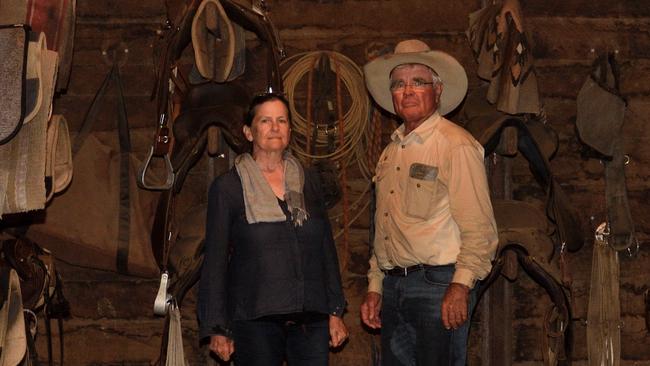
Peter and Jane Hughes are doing just what they have been doing for years – and admit they would still like to do more often; together inspecting their cattle mobs and property infrastructure on Tierawoomba station to make sure they are doing the best for their land and their livestock.
Or discussing with his staff how his many outstations, newly acquired add-on properties and more than 50,000 black Wagyu cows are faring in the relatively dry summer.
An experienced – and championship-winning – campdrafter, Peter still tries to ride his horses or muster mobs every day at home, when he is not in Brisbane, Rockhampton or Sydney wrangling corporate deals instead of cattle.
“There is simply no substitute for putting the hours in (when you are running a big property),” explains Hughes, as we explore his newly acquired 10,000-hectare farm, Saltbush Park, which he has just tacked on to the northern boundary of Tierawoomba, a station originally owned by Peter’s great-great-grandparents in 1872, which Peter is now determined to restore to its best.
“You’ve got to work with your people, and really understand the land and cattle. You see a bit from a plane, more from a car, but there is nothing like riding and mustering the country to really feel it; the fall of it, where the dams will go and the best way to fence it.”
Despite buying and selling many large cattle properties in the past 20 years – with Hughes propelled into the national spotlight as the central figure in the massive $490 million takeover of Stanbroke Pastoral from AMP in 2003 – Tierawoomba is the only one of their five outback stations that has been in the family for generations. Jane’s family, the Templetons, originally owned Tierawoomba back in the 1870s, with her forebear Robert Templeton giving his name to the original Tierawoomba brand, RT5.
After changing hands a few times, Peter’s grandfather bought what was left of the once-gigantic station in 1906. Peter’s father, Brian, married Sibyl, the eldest daughter of the neighbouring Shannon family in 1946. Peter – educated at home and then at boarding school in Southport – took over after he married Jane, the daughter of a local Capella grazier. He had no idea of her heritage links to Tierawoomba at the time.
Since then, Tierawoomba station has expanded substantially, along with the Hughes family’s fortunes, with surrounding stations including Cardowan, Saltbush Park and Sirram – all once owned by Peter’s mother’s family – along with Mount Scott, Waitara and Urani, all added. The new “Tierawoomba aggregation” now stretches 80 kilometres between Sarina and the small local hamlet of Clarke Creek.

Many of Hughes Pastoral’s 25-30 permanent staff live in the raised “Queenslander” houses and single men’s quarters on the four outstations dotted across Tierawoomba.
There is now a 150-hectare hay farm added to its repertoire, with more than 5000 big bales of high-protein organic vetch, legumes and cowpea hay grown annually under a massive centre-pivot irrigator to supply feed to Georgina Pastoral’s vast organic cattle stations.
Yet the nucleus of Tierawoomba remains humble. Peter and Jane live in a small grouping of 100-year-old timber slab buildings cut from local trees, nestled under shady tall trees, covered with bright flowering bougainvillea and surrounded by green grassy lawns and the odd orphan joey.
There is little sign of affluence or wealth. The main homestead is no grand, airconditioned modern edifice full of shiny new appliances and flanked by swimming pools and garages full of Mercedes. Instead it feels more like a remote outback central station far from civilisation, almost a village in itself, where little has changed other than its – sometimes unreliable – mobile phone access and permanent power.
The working cattle yards and machinery workshop are just across from the main house, filled with battered utes and side-by-side bikes – the company bans quad bikes – while the original small white slab cottage, more than 150 years old, is home to the station cook.
Breakfast is at 5.15am and dinner at 6pm, with ample slabs of beef, Wagyu of course, carved by Peter Hughes. Cook Makayla Talbot, married to head stockman, Kyle Lochie, bustles around the kitchen as their young toddler, Kobe, totters outside, happily calling Jane Hughes “Nana”.
Jenny Acton, a close friend of Jane Hughes since before they were both married, says the couple have always been inseparable.
“Whenever you see one, you see the other,” says Jenny, wife of the late Rockhampton cattleman, Graeme Acton, who had similarly known Peter Hughes since birth before his fatal accident at a campdrafting event at Clarke Creek near Tierawoomba in 2014. “They’ve been great friends of ours for years and we always go to each other’s family events.
“Graeme and Peter used to talk for hours about their great loves – cattle, horses, campdrafting and their properties – and were always really supportive of each other; Peter gave the eulogy at Graeme’s funeral.
“I’ve got a lot of respect for Peter as he has branched out and become a big player in the (cattle) industry – he is so knowledgeable and has always been a very good horseman. Jane is more private and reserved; but she’s really proud of what they have achieved together.”
Peter Hughes clearly relishes the life he and Jane have carved out at Tierawoomba, even though their two adult sons, Sam and Fred, have married and left home to manage far-distant company stations.
From 5am every day he is on the phone to his two sons and other station managers spread across Queensland and the NT; by 6am, breakfast is over, the ringers and stockmen are heading out to their horses, helicopters and utes ready for mustering and farm work and every arm of the far-flung business knows who is doing what, where and when.
Oldest son Sam, 39, and his wife, Amanda, recently moved to the family’s sprawling red-dirt outback Channel Country station Keeroongooloo, on the banks of the legendary Cooper Creek near Windorah, with baby Pete named after his illustrious grandfather. Second son Fred, 37, his wife, Sarah, and three boys aged under five live six hours drive southwest of Tierawoomba, at prized Tumbar station south of Jericho in central Queensland cattle country between Rockhampton and Longreach.
“I leave the day-to-day management to Fred and Sam now, except at Tierawoomba,” Peter says. “I’m the big picture person now; it works well.”
Both sons fly helicopters and planes, with family reunions usually a fly-in affair at Tierawoomba, featuring barbecues under the trees and fierce campdrafting competitions on the purpose-built grass arena beyond the homestead.
“We all work very well together,” Fred says. “Peter has made a lot of very good decisions in his time; going into Wagyu cattle so early was one of them. He is also great at putting a good team together and inspiring loyalty. For me, he’s been an exceptional mentor and role model.”
Sam agrees. “Dad organises but delegates, leads from the front, achieves so much and does it effortlessly. He’s a very practical man; everywhere I go he is well respected for his love and understanding of the bush, the people and the animals in it.”

Long-time Queensland rural property agent Rawdon Briggs says the Hughes family remains a rarity in today’s high-powered cattle world where hallowed stations are changing hands for $50 million-plus, mainly to superannuation funds and corporate players.
“Peter has a great eye and has gained fantastic land assets over the years; but he’s also not afraid to have a go,” Briggs says. “And it’s always with his own money and no one else’s.
“He’s strategic and a shrewd operator; his view is that if you are presented with a good offer (for land you own), it’s a good idea to take it and not be sentimental about things; you do what’s best for your business and your family.
“He always says that nothing should not be for sale – that at different times you sell and you buy – other than their home place. He would never sell Tierawoomba; that’s different – we all know it will never be for sale.”
Peter Hughes says he has just done what has made good business sense at the time. “I’ve sold some very good properties to people like Paraway Pastoral when things have got tough, but generally when I buy good places, I’m always in it for the long haul if I can.”
It’s late afternoon at Tierawoomba and mustering of a big mob of six-month old young cattle, who will spend the night in the home yards while they adjust to being apart from their mothers, is underway amid cool misty rain.
Peter Hughes is in the saddle, working with his head stockman and three young ringers to gently move the Wagyu weaners through the lush grass.
But this year is a little different. It is the first year Hughes Pastoral and Georgina Pastoral company have committed to their entire cattle herd of more than 50,000 cows, their calves and young weaners all being purebred Wagyu cattle.
The massive herd – the combined properties have an ultimate capacity of 120,000 head – has been bred by the Hughes family over the past 30 years by crossing select full Japanese bloodline Wagyu bulls from their own stud with the Brahman-Hereford cross cows that had previously run at Tierawoomba for decades.
Now, with the herd past its fifth generation of Wagyu crossing, their cattle are all at least 96 per cent Wagyu blood, and officially deemed to be purebred, and therefore the most prized, black Wagyus. It’s perfect timing in a year cattle prices Australia-wide have reached record levels and Wagyu meat is commanding 50-80 per cent premiums because of its unique fat marbling characteristics.
“I’m absolutely happy we’ve made the complete switch; Wagyu is so valuable,” says Hughes, who sells most of his steer (young male) cattle when they are 18 months to 2½ years old under long-term contracts to top Wagyu beef brands such as Rangers Valley, Pardoo and Jacks Creek, which then fatten them for another 13 months on grain before slaughter.
“This year, if I had been selling a composite (northern Australian) steer, like the ones we used to have, to Rangers Valley that we had backgrounded on Tumbar, it would have fetched $1600, which is still a remarkable price.
“But I’ve been getting $2700 for my Wagyu backgrounders going to the feedlot at 400kg; with a turn-off of between 20,000 and 30,000 head a year that’s a big difference (in income).”
Hughes says his companies could not have gone all-Wagyu any earlier than 2020 without spending a lot on artificial breeding, because he did not own enough purebred Wagyu cows. But now he sold all of his remaining non-Wagyu Angus-based Ultrablack cattle, Hughes can now guarantee he has bred his entire purebred Wagyu herd himself, and thoroughly knows its genetic potential and traits.
Despite their Japanese origins as beasts of burden, Wagyu are extremely tough cattle, and have shown over the past three decades they can thrive in hot, tropical northern and outback environments, can walk long distances to water, are extremely fertile and produce beautifully marbled meat. The value of their beef more than makes up for their slightly slower growth rates.
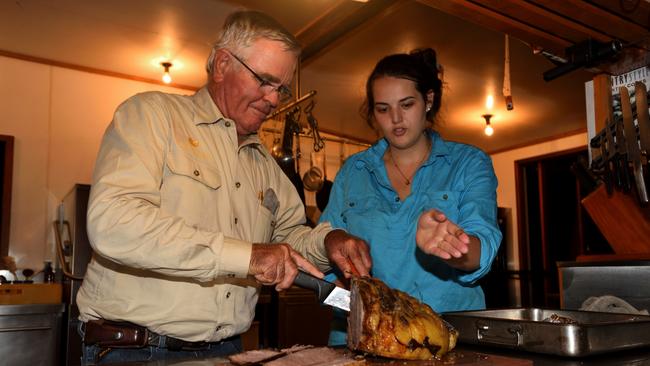
Many of Australia’s largest beef producers, including the listed Australian Agricultural Company and Australia’s richest woman, Gina Rinehart, have also followed Hughes’ lead and are now converting their cattle herds to Wagyu genetics.
Don Mackay, a former managing director of both AACo and Rangers Valley Meats who has known the Hughes family for years, credits Peter Hughes with showing the way among northern Australia’s big cattle producers by his unswerving belief in the Wagyu breed. Mackay admits he was left behind in Hughes’ wake many times.
“The introduction of Wagyu was somewhat of a risk, as no one knew if it would work in northern Australia, but Peter clearly saw something and introduced them into his commercial herd very early on,” says industry stalwart Mackay.
“And the Wagyu proved to be so fertile and robust; they not only survived but thrived in the north in Peter’s hands. They originally had been bred as draft-animals and they reverted from their more recent pampering and proved bulletproof; that was a revelation to us at AACo and we had been watching very closely what Hughes had done.
“In hindsight, it’s amazing the confidence Peter had and his readiness to back his judgment and belief in the Wagyu with his own money and family commitment when so many people in the industry were saying he would fail; to run against the tide like that is the mark of someone with vision, who is strategic and has a good streak of entrepreneurship.”
In the bush at Tierawoomba, Wagyu cows with their young calves at foot thread through the gum trees like black shadows. They are everywhere – and clearly thriving – with both Peter and Jane openly delighted by their success.
For Jane, some of her appreciation of the Wagyu breed is aesthetic. “Only the Japanese could have bred the Wagyu because they always aim for perfection, to get the very best outcome,” she says, having enjoyed several trips to Japan meeting its top Wagyu breeders. “Isn’t it a marvellous thing that the Japanese are always with us; they are real friends.”
For Peter, there is an added economic element to his quiet satisfaction, to be riding the wave of the highest cattle prices in the world.
“It’s remarkable, quite extraordinary; I never thought I would see prices like this in my lifetime,” says Hughes, who has endured his share of hard times and many visits from the bank manager as he has bought and sold big stations.
So far Peter Hughes’ only personal concession to record cattle prices has been his $130,000 purchase of a top campdrafting stallion. Its first foals have just been born – the Hughes breed all their own stock horses at Tierawoomba and Lake Nash – and Peter is ecstatic as he inspects them in the paddock. “I’ve never spent that sort of money on a horse before,” he says.
For Hughes, all his extra wealth is being ploughed back into the business. New stockyards installed, outstations improved, dams built, bores drilled and paddocks fenced. There are extra funds for his Wagyu genetic improvement program. “It’s a great feeling; I can’t think of a better way to spend it,” Hughes says.
“There’s no quick fixes in this industry; I always like to say that the fastest way to move cattle is slowly. That’s true of everything; if you try to take a short cut, you will fall in a hole and it will take you half as long again. That’s not my way.”
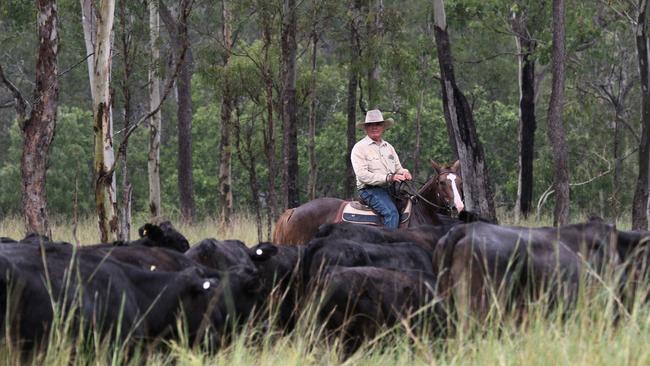
HUGHES FAMILY EMPIRE
The Hughes family’s cattle empire sprawls across northern Australia, from the grassy but dry Barkly Tablelands of the Northern Territory, south to the legendary red dirt Channel Country of Cooper Creek in far western Queensland, and spread across the Central Queensland pastoral heartland between Alpha, Tambo and Nebo.
It’s a network of five stations gradually expanded through the persistent buying of neighbouring or nearby properties, and now run as two linked companies – Georgina Pastoral and the Hughes Pastoral Company.
The combined expanse of the Hughes family holdings is vast. The Lake Nash aggregation southwest of Camooweal, where the Gulf country meets the Lake Eyre basin, outback Keeroongooloo station near Windorah, beautiful buffel grass-covered Tumbar in the Jordan River Valley at Jericho, Caldervale with its brigalow scrub near Tambo and the ever-growing heartland home base of Tierawoomba Station between Nebo and coastal Sarina, cover nearly three million hectares in total.
It’s a diverse network of some of the best and most reliable country in northern Australia, put together by Hughes as he has quietly sat at the centre of some of the biggest cattle station transactions and rural land deals of the past two decades.
In 2003, Hughes was a key part of a $490 million winning joint bid, together with several other Queensland grazier families, Hungry Jack’s founder Jack Cowin, and Victoria’s Menegazzo family, that bought the biggest cattle company in the world, Stanbroke Pastoral, from AMP. It was a stunning corporate play that brought Peter Hughes to (largely unwanted) national attention.
The 12 million hectares of Stanbroke’s prized land was then split between the partners, with Hughes and long-term Stanbroke manager Bill Scott together walking away with their share of central and northern Queensland properties to form Georgina Pastoral company.
In 2006, Georgina Pastoral expanded further, snaring the $300 million portfolio of seven Queensland heritage cattle stations owned by the Colonial Agriculture Fund.
Three years later, the Hughes-Scott partnership ended when they sold a large number of the cattle stations they had accumulated from both Colonial and Stanbroke – covering 2.5 million hectares of north Queensland – to the Macquarie Agricultural Fund for $169 million, forming the basis of its sprawling Paraway Pastoral conglomerate.
Hughes walked away with the Georgina Pastoral name, his $200 million share and the beginning of his new land empire. Hughes chose to keep massive Lake Nash station on the Barkly Tablelands (formerly a Stanbroke property), Keeroongooloo in the Channel Country near Windorah and the Caldervale brigalow scrub station near Tambo.
Further small adjacent stations were added in the intervening years. Argadargada was added to Lake Nash, Mount Lindsay joined on to Caldervale and Cardowan on the Connors River expanded Tierawoomba further.
Then in 2016, in one of the biggest single rural land deals ever, Hughes Pastoral paid a record $67 million to snap up 69,000-hectare Tumbar Station west of Rockhampton. The deal included 8000 Angus cattle worth $10 million.
In June 2019, as cattle prices began to soar, Hughes paid $11 million for the 121,400-hectare Cawnpore Station between Boulia and Winton. The 10,000-hectare Saltbush Park station was added to Tierawoomba’s boundaries last year.
“Peter is one of the shrewdest land buyers and cattle operators around,” says Colliers International’s Rawdon Briggs. “He picked the eyes out of the ex-Stanbroke and former Colonial stations; it’s a very diverse geographical spread but it has also given them flexibility to reduce risk.“
With such expansive holdings, cattle numbers are also impressive. The Hughes have the largest family-owned commercial Wagyu herd in Australia, and are close to their ambition to be running 130,000 purebred Wagyu. There are now more than 50,000 full-blood Wagyu cows, with 25,000 Wagyu steers turned off a year.
GEORGINA PASTORAL COMPANY
Lake Nash Station (plus Georgina Downs and Argadargada Stations), Barkly Tableland NT
1,700,000ha
Cawnpore Station between Boulia and Winton
121,400ha
Keeroongooloo (and Yeppera) Windorah/Cooper Creek QLD
700,000ha
Caldervale (including Carwell and Mt Lindsay) Tambo QLD
172,000ha
HUGHES PASTORAL
Tierawoomba Station (plus Cardowan, Mt Scott, Snake Creek, Sirram, Main Range, Saltbush, Waitara, New Yard, Mt Whyte and Urani outstations), Nebo QLD
160,000ha (Pastoral)
Tumbar (and Marsden), Jericho QLD
69,000ha
Colomendy Wagyu stud, Bundarra, New England, NSW
2500ha
MORE
WHO OWNS AUSTRALIA’S FARMS 2021


